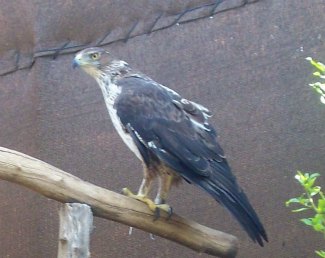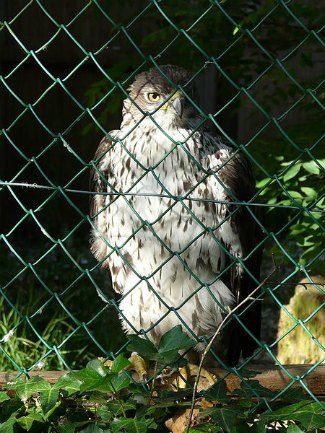Bonelli's Eagle - Aquila fasciata
By Osado, CC-BY-3.0, via Wikimedia Commons
Family: Accipitridae
Genus: Aquila
Species: A. fasciata
Subspecies: A. f. fasciata, A. f. renschi
Bonelli's Eagles are large brown-and-white eagles that live in a variety of habitats and have a large range spanning several continents. They form a superspecies with Aquila spilogaster (African Hawk Eagle) and a clade with A. africana (Cassin’s Hawk Eagle), A. audax (Wedge-Tailed Eagle), Aquila chrysaetos (Golden Eagle), A. gurneyi (Gurney’s Eagle), and A. verreauxii (Verreaux’s Eagle).
Description:
Bonelli’s Eagles are slender eagles with short, rounded wings and a long tail. The back and wings are dark brown, while the belly and underparts are white with brown spots. The wings have a white leading edge, black terminal band, and a gray patch at the carpal joint. The legs are long and feathered. The eyes are yellow-orange and the feet and cere are yellow. Subspecies A. f. renschi is smaller than the nominate subspecies A. f. fasciata and has bolder markings on the belly and thighs.
Juveniles, harder to distinguish from other raptors than adults, have a pale chestnut underside and their eyes are hazel.
Bonelli's Eagles can live up to 32 years in the wild.
Size:
Length: 65-72 cm
Wingspan: 150-180 cm
Weight: 1.6-2.6 kg
Habitat and Distribution:
Bonelli’s Eagles occupy dry, open and semi-open habitat, mountainous regions where there are cliffs, valleys, and gorges, and have been found in lowlands and wetlands outside of the breeding season. The eagles found in northern Africa prefer hilly, forested areas.
They live around the Mediterranean, through northwest Africa, across the Middle East to southern China and India, and down through Southeast Asia. They are usually found 0-1,500 meters above sea level, often around 660 m, spanning a range from 45°N to 10°S. Adults are sedentary, but juveniles disperse from their breeding areas to avoid competition with other Bonelli's Eagles. There are approximately 10,000 individuals.
Diet and Hunting:
Their diet includes a range of animals, from birds such as pigeons, partridges, crows, ducks, gulls, and even large herons, to lizards and small mammals including rats and bats. They rarely eat carrion.
By Père Igor, CC-BY-SA-3.0, via Wikimedia Commons
Bonelli’s Eagles hunt by watching for prey from a perch, quartering hills and flat ground, or by swooping down from the air. Most of their food is taken on the ground, but they can catch birds midflight. They have a long hind claw and powerful feet, which enables them to take relatively large prey for their size.
Reproduction:
Breeding displays consist of steep dives and upward swoops and a displaying pair will occasionally call to one another. The breeding season is from January-July in the western part of their range and November-September in Asia. Adults often remain partners outside of the breeding season.
The nest is commonly built on cliffs, though some have also been found on electricity pylons and large trees. A usual Bonelli's Eagle nest is set 9-36 meters above the ground and starts off at a relatively modest size of about 1.5 meters (5 feet) in diameter—after consecutive use, the nest grows much bigger. Pairs may have up to five different nests within their territory. A clutch of 1-3 eggs, usually 2, is laid, and incubated for 37-40 days. Most of the incubation is done by the female, with the male bringing her food. Fledging takes 55-65 days.
Conservation:
A major threat to Bonelli’s Eagles is electrocution, since 50% of Bonelli’s Eagle deaths were due to electrocution in Spain; 47% in France. They sometimes kill domestic and homing pigeons, in addition to being viewed as a threat to wild game, and are illegally poisoned or shot. Their habitat is being destroyed due to development, roads, and forest plantations. Human activity has also caused breeding failure and the birds to abandon their territories.
However, despite these issues, Bonelli’s Eagles are currently listed as Least Concern by BirdLife International, due to a slow overall decrease in population and their large range.
Taxonomy:
Aquila fasciata forms a superspecies with Aquila spilogaster (African Hawk Eagle); the latter used to be considered a subspecies of Aquila fasciata, but is now considered separate. Both species were placed in the genus Hieraaetus but recent DNA sequencing of mitochondrial and nuclear genes has shown they are more closely related to Aquila.
Aquila fasciata is part of a clade formed by A. africana (Cassin’s Hawk Eagle), A. audax (Wedge-Tailed Eagle), Aquila chrysaetos (Golden Eagle), A. gurneyi (Gurney’s Eagle), and A. verreauxii (Verreaux’s Eagle).
Subspecies:
There are two subspecies: A. f. fasciata occurs over most of the bird’s range, from the Mediterranean to Asia and A. f. renschi is found only on the Lesser Sunda Islands: Sumbawa, Timor, Wetar, Luang, and Flores. According to some authorities, A. f. renschi may be a separate species. Since, however, it is still classified as subspecies by others, it is listed as such on this wbesite.
Other Names:
Uzunquyruq qartal (Azerbaijani), Høge rn (Danish), Havikarend (Dutch), Vuorikotka (Finnish), Aigle de Bonelli (French), Habichtsadler (German), Haukörn (Icelandic), Boneri-kumataka (Japanese), Aquila del Bonelli (Italian), Haukørn (Norwegian), Orzelek poludniowy (Polish), Áquila perdicera (Spanish).
Video of Bonelli's Eagles:
References:
http://avibase.bsc-eoc.org/species.jsp?avibaseid=05F1144132A7E4FF
BirdLife International (2011) Species factsheet: Aquila fasciatus. Downloaded from http://www.birdlife.org on 21/10/2011.
http://www.europeanraptors.org/raptors/bonellis_eagle.html
Global Raptor Information Network. 2011. Species account: Bonelli's Eagle Aquila fasciata. Downloaded from http://www.globalraptors.org
on 21 Oct. 2011
BirdLife International 2009. Aquila fasciatus. In: IUCN 2011. IUCN Red List of Threatened Species. Version 2011.1.
www.iucnredlist.org. Downloaded on 21 October 2011.
http://www.planetofbirds.com/accipitriformes-accipitridae-bonellis-eagle-aquila-fasciata
Ferguson-Lees, James, and Christie, David A. Raptors of the World. Houghton Mifflin Company, 2001.

